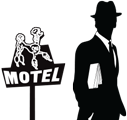David Pledger, curator, 2970° The Boiling Point
In a predominantly secular world, art provides meaning to daily life ...
Later this month, the City of Gold Coast will present a three-day symposium that will interrogate the space where arts, science, technology, architecture, politics and culture meet. It’s called 2970° The Boiling Point after the boiling point for gold, which stands as a kind of metaphor of sorts for the transformational effect art can have on society. The one-of-a-kind event is being curated by internationally renowned artist and director of pioneering interdisciplinary arts company, Not Yet It’s Difficult (NYID), David Pledger, and will feature keynote addresses from five innovative thinkers across genres including Professor Stelarc, who surgically constructed an extra ear on his arm in the name of art. The Weekend Edition Gold Coast caught up with David ahead of the symposium, which gets underway on June 26, to get some insight as to what audiences can expect from the event.
Can you tell us about 2970° The Boiling Point?
It’s a space in which anything can happen and probably will. Inviting artists and scientists, architects and social activists, thinkers across disciplines, agents of change across sectors, the local milk bar owner, surfers, I mean, really, there are so many opportunities for things to go awry – I find people really enjoy this atmosphere of possibility.
What conversations do you hope will transpire?
I’d love people to have conversations they’ve never had before, make friends they’d never dream of making and concoct magic they can work together to make happen.
Is there one event in particular that you are personally excited to see?
All the keynotes are really going to smash it out! They are so diverse, so on top of their game, so tantalisingly close to being in the future. I mean what will a guy like Stelarc do? He has an ear grafted on to his arm. Now you have to say that out loud to actually believe it’s true, and you’re left with a sense of wonder.
What do you hope will be achieved by the event?
I’d like to see artists, scientists, architects, technology geeks and sports jocks busting down the door to be part of the Gold Coast arts explosion that is building as we speak.
You’ve previously said that you think that the Gold Coast is the most exciting city in Australia to be an artist. Can you elaborate on that?
Firstly, the Gold Coast is not what you believe it to be. So it takes you by surprise. Secondly, Gold Coast artists think differently to artists elsewhere which means they create differently and thirdly, the lack of cultural infrastructure means artists can play a leading role in cultural development.
As part of the YARN and Über Mentorship program you have spent a lot of time on the Gold Coast over the past year. What was the most surprising thing you’ve learnt about the Gold Coast?
You can get really awesome coffee here.
What inspires you?
My dreams, my kids, people’s capacity for change and empathy, art that irritates, provokes, challenges and that’s aesthetically seductive.
How would you describe your style of art?
My style of art is one that’s led by ideas, and that has no loyalty to any particular art form. I don’t see boundaries like others do. That can get me into trouble. But I’m used to that now.
You’ve staged productions all around the world including in theatres, galleries, museums, a car park, stables, a cattleyard, a suburban house, a film studio and at the Australian Institute of Sport. What was the most challenging?
The film studio was a massive space outside of Ljubljana, Slovenia. It seemed like a good idea at the time but it needed ten thousand people to fill all the 3 studios. We didn’t quite get that number.
What have been some of your career highlights?
Probably being the first Australian artist to be invited to open the Vienna Festwochen, one of the major arts festivals in Europe in 2003 and then being commissioned to close a major Asian arts festival, the Seoul International Performing Arts Festival in 2005. Eavesdrop was the world’s first panoramic, interactive, narrative film, that was quite cool. And for The Meaning of Moorabbin, I rented a house, installed artworks in it and offered it up for auction. The audience mix for that work was so varied. I have a few others in train that could be quite awesome.
How do you personally define ‘success’?
Finding the right question to ask at the right time.
What’s the biggest lesson you’ve learnt in your career so far?
How to develop the right question.
When did you first discover your passion for the arts?
Either watching Ralph Cotterill in Kafka’s Metamorphosis at the Russell Street Theatre in Melbourne, or organising my year eight class to see Jesus Christ Superstar or eating Butter Menthols onstage during a uni student performance as a seven-year old. Actually I think it was watching Stanley Kubrick’s A Clockwork Orange at the Drive-in in a Mazda Capella – built for four but holding eight. I defy anyone not to be turned on by the arts in such a situation.
Do you have any advice for artists who are keen to build a career in the arts?
Careers are for bankers not artists. Artists need to make a working life. They need to respect and articulate the value of the work they do. In a predominantly secular world, art provides meaning to daily life. It’s a serious responsibility and we should take it seriously.
Finally, who are some emerging talents ‘to watch’ on the Gold Coast?
There’s not enough space to list them all.
Image Credit: Pia Johnson.

